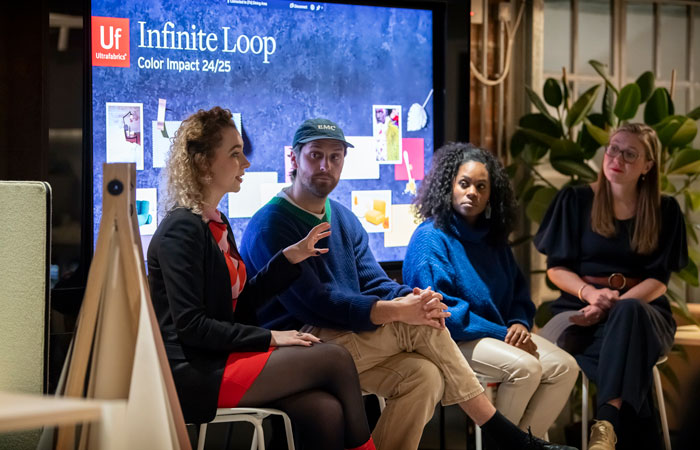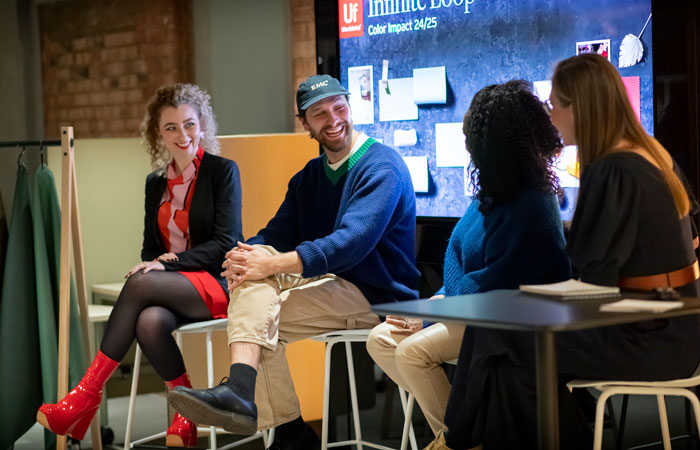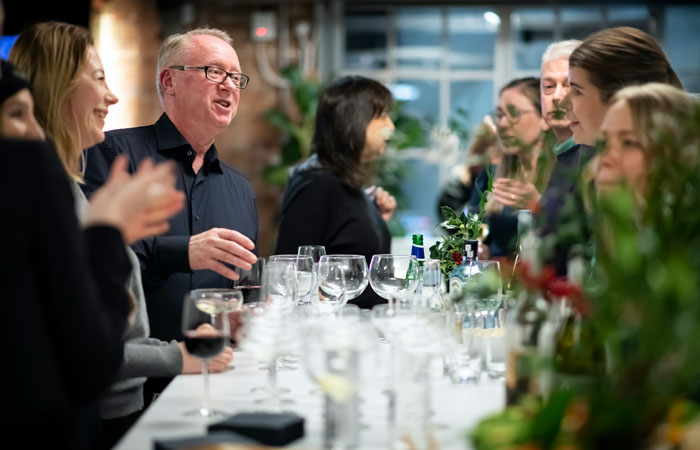Infinite Loop: Color Impact – Can AI + human centric design succeed without each other?
Last week we joined Ultrafabrics for the launch of ‘Color Impact 24/25,’ held in Senator’s Clerkenwell showroom. Ultrafabric’s report is more than just a forecast; it’s an exploration into the dynamic world of colour and texture for the coming years. ‘Infinite Loop’ stands at its heart, bridging the latest technological advancements with a comforting embrace of the familiar. Through five unique concepts, the report invites us on a reflective journey, considering both the past and future of design. Ultrafabrics presents this not just as a guide but as a conversation starter about the evolving role of colour and texture in our spaces.

Find UltraFabrics on Product Finder
Beyond trends, Color Impact explores the anticipated influence of colour and texture on design for the year ahead. Carefully curated by Ultrafabrics forward thinking product development team in collaboration with a global trend forecasting agency, the report is a forecast to empower designers and specifiers to design for the future.
For 2024/2025, Ultrafabrics introduces Infinite Loop. At the peak of technological advancement, its almost as if we’ve hit a glitch in the system. 2024 is beginning to look like an ‘Infinite Loop’ were we cycle between unfathomable technological advancement and a longing for the familiar. Comprising of 5 distinct concepts, Infinite Loop reflects of where we have been and where we are going.

On the night Ultrafabrics Marketing & Brand Manager, Genevieve Boaler, presented a preview from the report. ‘Atmosphere’ is a technical, futuristic, and earthbound concept, which explores how we are seeing nature and technology combine.

Natural earth tones, influences and materials are offset with technological processes, flecks of shimmer and metallics.

Sign up for the full Colour Impact report here.
Design Insider Managing Editor, Alys Bryan, introduced the audience to the evening’s speakers Kimberley Harrington, Automotive Advanced Design Sales Manager at Ultrafabrics, Toni Black, Director of Interior Design & Partner, Luxury & Lifestyle at Blacksheep, and Simon Chuck, Creative Lead at NewTerritory.
Alys engaged the audience with a thought-provoking anecdote about a LinkedIn post she had recently come across. The post firmly stated, ‘if you can’t be bothered to read it, then I can’t be bothered to write it!’ – a comment on the growing use of AI in generating copy text. Reflecting on the article and the ensuing discussion in the comments, Alys shared that she perceived a clear sentiment: the choice to use AI in creative processes seemed binary – an ‘all or nothing’ decision. It appeared one must either staunchly protect their craft by rejecting technological advancements or fully embrace technology, letting it take over the creative output entirely. In her introduction to the panel discussion, Alys challenged the audience to consider if a nuanced approach could enable craft and technology to collaboratively work hand in hand, benefiting everyone involved.

When we talk about advancements in technology this could mean technology used for production, technology used as a design tool, or technology integrated into the realised product. Could you talk us through examples of the most recent and most exciting technological developments?
Simon: When we talk about technology for production I think we have to focus on materiality. What a product or space is built from and how those pieces come together will be a fundamental driver to its future success. We’ve seen this through a change is customer desire which is shifting, causing people to seek products with purpose, ones that have strong eco credentials and this must shine through in how they are made.
When we talk about technology as a tool we have to talk about AI. Ever growing advancements in generative design tools are allowing designers to rapidly iterate and expedite the design process, embracing AI as a colleague rather than a rival will be key to our future creative workflow.
AI itself is now starting to naturally flow into how the products we design operate. Reading a user’s wants and needs in an instant. Looking at signals and signs from mood through facial expression to biometric readings to predict health. Future products will be able to create hyper personalised experiences, perfectly tuned to each individual, using this big data.


What role does ‘craft’ play in an AI world and in what ways can this be leveraged to inject purpose into a design?
Kimberly: Craft will continue to play an important part in our growing AI using world. Human skill, knowledge and history will be relied on to input and gatekeep the growing implementation of AI. We as humans and designers will educate, regulate, and write the ‘code’ to feed the software and databases that form AI. In terms of leveraging craft to inject purpose into design, I believe AI and craft can provide complimentary harmony to celebrate the naturally occurring design features of the handmade while growing a new appreciation for the AI generated artwork and what is becoming a recognisable style. There is room and merit to include both in a design process. AI leverages potential to generate many ideas or start points to provide more variety and input, it still relies on human input to advise from a human aspect and experience. AI can generate a number of potential solutions to design but will still rely on the human senses to determine what is right for an individual, environment or end product designed to be used or enjoyed by humans.

This event highlighted a key insight: the fusion of technology and traditional craftsmanship is shaping the future of design. The panellists, Simon, Toni, and Kimberly, brought to light the importance of this synergy, posing a new question: Can AI + human centric design succeed without each other?

‘Infinite Loop: Color Impact’ goes beyond being a trend report; it serves as a lens to view the evolving design landscape, reminding us of the harmonious potential when technology meets tradition. For a deeper exploration of the vibrant world of colour and texture envisioned in ‘Infinite Loop: Color Impact,’ you can access the full report here.
Contact UltraFabrics through Product Finder
Product Finder enables Commercial Interior Designers to source products and services from accredited Commercial Suppliers. Search through over 200 UK suppliers, each showcasing newly launched products, projects, catalogues, films, sector research and much more.




